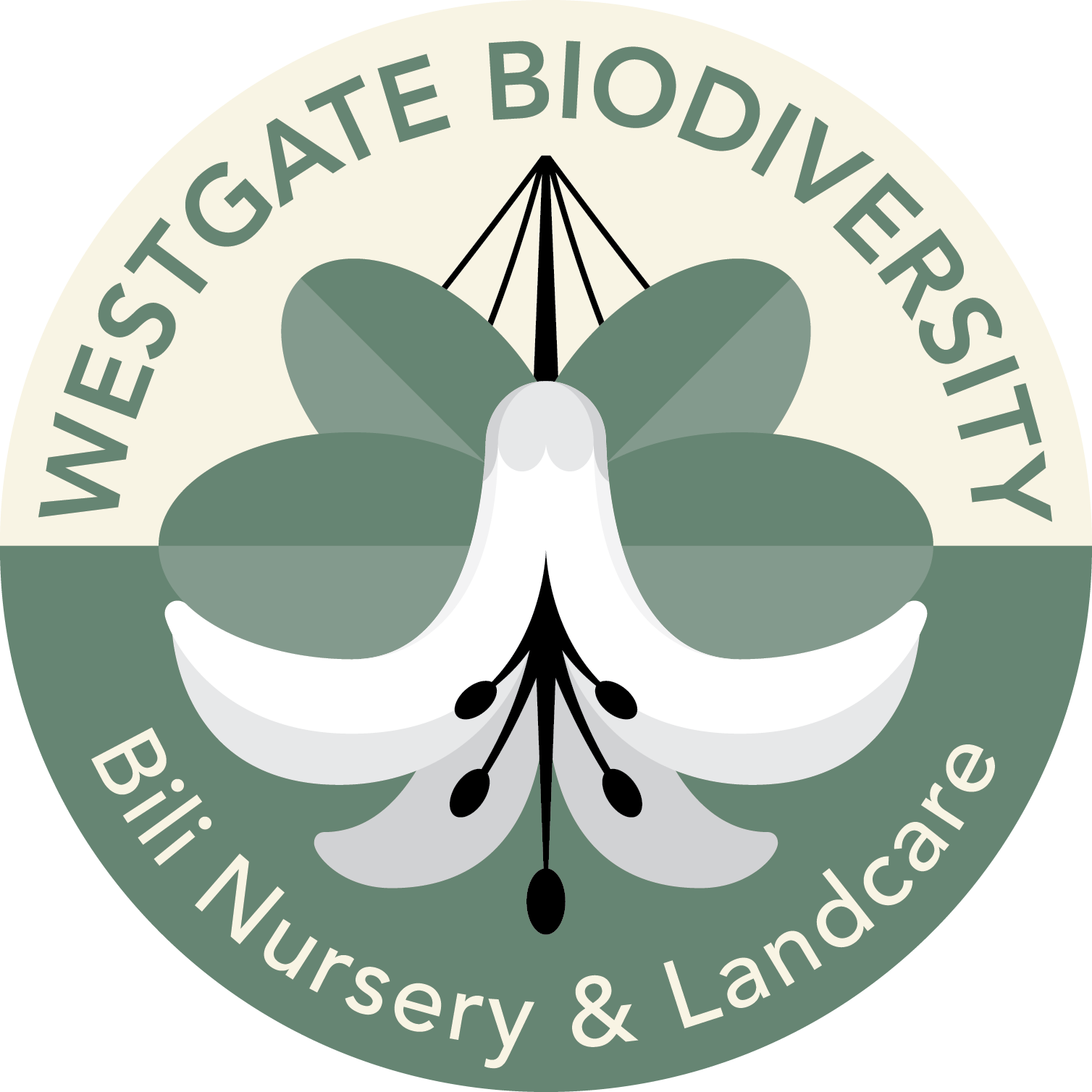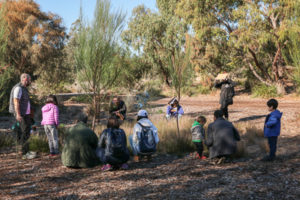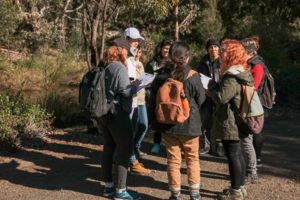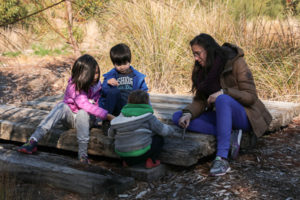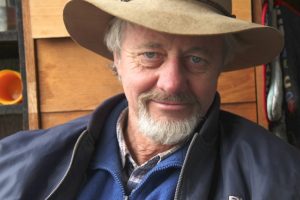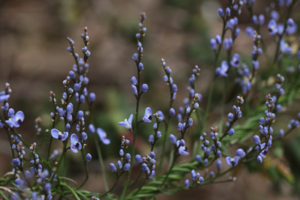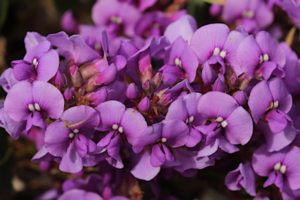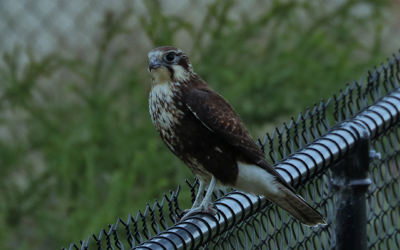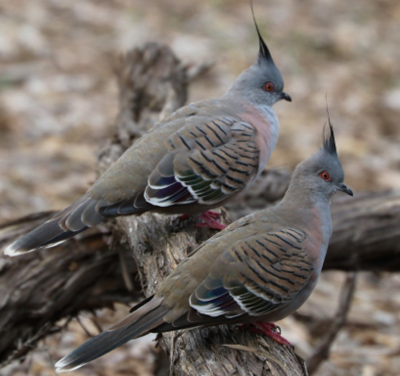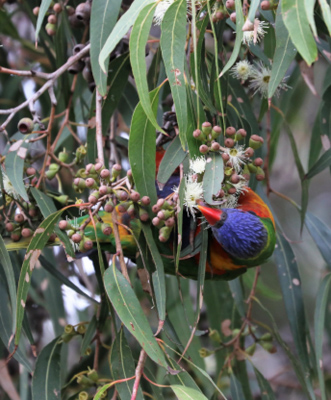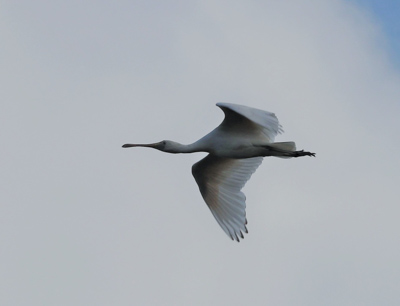Luis Mata on pollinators, ABC RN

Hear Luis talking about pollinator insects in the City of Melbourne, the pollinator observatories at Westgate Park, the import role insects play in supporting healthy parklands and why understorey plants are necessary to foster this.
ABC Radio National Blueprint for Living, Saturday 18 August 2018, listen here.
Quick facts:
- over 600 species of insects have been discovered by Luis Mata’s RMIT team
- there are estimated to be more than 1 million species of insects worldwide and 1,500 in Melbourne
Download below the beautifully illustrated children’s book: The little things that run the city, created by Kate Cranney, Sarah Bekessy and Luis Mata, in partnership with the City of Melbourne
Blue-banded Bee, photo Luis Mata
National Tree Day(s) 27 & 29 July
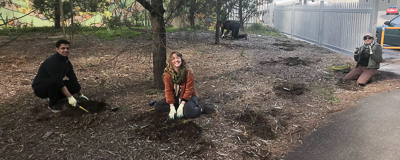
Westgate Biodiversity: Bili Nursery & Landcare and 77 eager volunteers planted over 2000 indigenous plants at three events to celebrate National Tree Day:
- Friday. City of Melbourne staff, their Citizen Foresters plus 14 volunteers put in more than 500 understorey plants along the Maribyrnong River. The site had magnificent Eucalypts, Sheoaks and various other trees but no groundcovers, wildflowers and small shrubs.
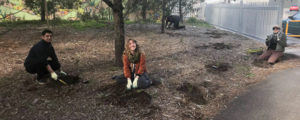
- Sunday. At Elwood Beach 35 volunteers put in over 1000 coastal plants to increase the habitat for the small colony of Superb Fairy Wrens and other birds that use this section of foreshore.

- Sunday. At Westgate Park 28 volunteers from 15 Trees planted 500 wetland plants in the new western section of Southern Wetlands. This wetland will become excellent habitat for birds, frogs and insects.
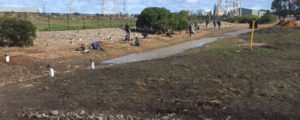
These planting activities help form corridors for small animals and critters that are overlooked when only trees and non indigenous shrubs are used. Indigenous understorey species provide good cover and they flower at different times of the year, providing food for caterpillars and vital nectar and pollen for native birds, bees and other insects. These are in turn food for the Superb Fairy Wren and of course other small birds.
Did you know?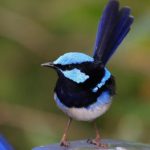
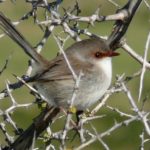
- Superb Fairy Wrens form family groups – generally one male, several females and the young. They feed on insects on the ground and in low bushes.The female incubates the eggs alone, but the whole family group helps feed the young.
- Bili Landcare plants all year round at Westgate Park – Monday to Wednesday and the third Sunday of each month and Bili Nursery operates weekdays and Saturday mornings and grows over 200 species of indigenous plants. We supply 100,000 plants every year for projects like these.
Check out our page for volunteering options that might interest you.
Monarch visits

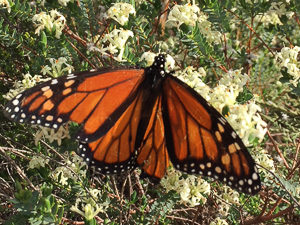 The Wanderer – Danaus plexippus or Monarch, shown here on Pimelea sp. – Rice Flower, is an uncommon and somewhat puzzling visitor to Victoria. According to Museum Victoria’s Butterflies: Identification and Life History:
The Wanderer – Danaus plexippus or Monarch, shown here on Pimelea sp. – Rice Flower, is an uncommon and somewhat puzzling visitor to Victoria. According to Museum Victoria’s Butterflies: Identification and Life History:
Populations are temporary in Victoria and migrating adults recolonise Victoria annually. Two or three generations can occur if migrating adults arrive in early spring.
…. In northern Australia the food plants are widespread weeds but in Victoria Gomphocarpus fruticosus – Swan Plant is grown more as a garden ornamental.
….. It is known as the Monarch in North America where it is noted for its large, long-distance migrations to overwintering sites in California and Mexico. Some limited migration also occurs in Australia and small overwintering colonies are known from SA and near Sydney.
Pollinators workshop

At our winter workshop participants learned to identify several insect pollinators, including native and non-native bees and butterflies. We then visited the pollinator observatories to make observations of plant-insect interactions.
This was the fifth in this series of workshops and each time we have seen something unexpected just through observing more closely.
Stay tuned for the results!
George’s blog
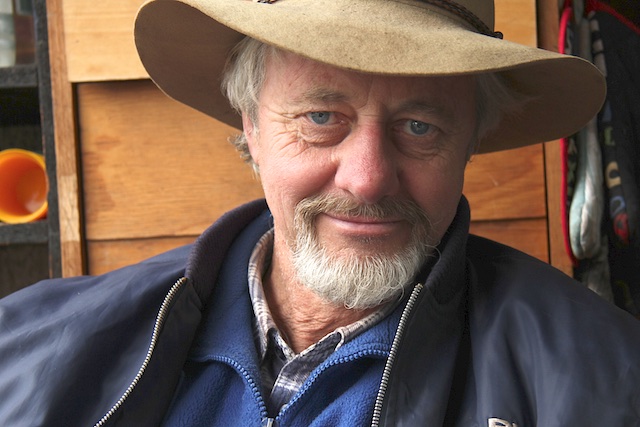
Having planted many thousand plants a year for 18 years through all types of weather conditions, I am building up a lot of knowledge about what survives and what doesn’t. Influencing factors include soil moisture (too dry or too wet), attack by rabbits, possums, rats and birds, lack of mycorrhizal associations, drought and waterlogging, soil pH and encroaching shade and competition.
Then there is also natural senescence. What is the life expectancy of a poa tussock or a goodenia? I have learned to plant only the hardiest types in the harshest sites, a hard won lesson by experience. Then sometimes a favourite plant such as blue devil thrives when I have almost given up on it. Possibly because of higher year round moisture or maybe a hardier variety.
Then there is a host of special and colourful plants that I have being trying to establish for years that hardly survive their first summer. Plants such a native heath, blue stars, hoary sunray, love creeper, trigger plant, common beard heath, orchids, stackhousia and many more. Yet these grow exceptionally well in their natural habitats, sometimes in the harshest or driest sites. I suspect they have their own special mycorrhiza and other soil flora aiding their survival which are lacking in the park.
The soil in Westgate Park is all imported from countless sources. A few years ago we investigated commissioning a study into beneficial soil flora and fungi with the aim to perhaps introduce what was missing. However the cost was prohibitive and it went no further. Meanwhile we just keep plugging away trying different sites, soil conditions and summer water regimes.
Love Creeper (Comesperma volubile) has now brightened up our heaths each spring for a number of years and Hardenbergia is now a spectacular resident.
The challenge now is to pass on the accumulated knowledge to those that follow. Record keeping is not my strong point but totally necessary.
July 14, 2018
What a way to mark World Environment Day!
On 5 June, 127 volunteers in three teams joined our Bili Landcare crew of 15 to plant, mulch and clean up the River bank at Westgate Park.
- Community Volunteers Australia arranged for 96 enthusiastic workers from Aon, Origin, FujiXerox, Energy Australia, Bridgestone, BASF and TabCorp and they put in around 2,500 plants.
- Landcare organised 8 Telstra volunteers who did a good day’s work mulching and planting
- Covestro Australia sent 8 staff to remove litter from our stretch of the Yarra River bank which is no easy task on that rock wall.
Thanks to everyone involved!
Website under construction!
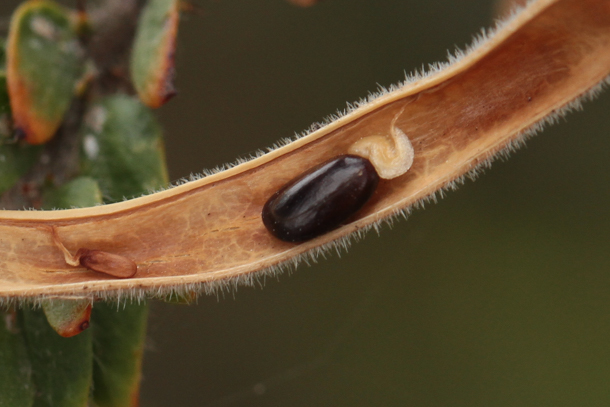
 We are building our website so you can have access to a wide range of information about and photos of indigenous plants, those we grow and those we plant.
We are building our website so you can have access to a wide range of information about and photos of indigenous plants, those we grow and those we plant.
Read about the transformation of Westgate Park by Westgate Biodiversity’s Bili Landcare and there will soon be a shop where Bili Nursery plants and other products can be purchased online.
See too our upcoming events in the sidebar.
Thanks for your patience!
May 2018 bird survey
Diving feeders – Hardheads, Australasian Grebes and Hoary-headed Grebes – in better than average numbers suggest aquatic invertebrates and other small prey are plentiful in Freshwater Lake. With levels of both main lakes remaining fairly high, conditions are good for supporting birds.
Visiting nectar feeders, especially Rainbow Lorikeets, Musk Lorikeets and Red Wattlebirds, abound in the park’s large Spotted Gums, which have flowered since April.
Our resident observer recorded a diverse range of visiting raptors during April. One Brown Falcon may be staying on, as it was also seen today in Howe Parade Extension south of the bridge.
The frequency of spoonbill sightings on Freshwater Lake last month provides more evidence of suitable food available for wetland bird species.
Also of interest is the increasing range of honeyeaters in the park, with White-naped Honeyeaters recorded this survey.
| Species | No. seen | Species | No. seen |
| Brown Quail | Galah | ||
| Black Swan | 2 + 6D | Little Corella | |
| Australian Shelduck | Sulphur-crested Cockatoo | ||
| Australian Wood Duck | Rainbow Lorikeet | 65+ (*15) | |
| Pink-eared Duck | Musk Lorikeet | 42 | |
| Australasian Shoveler | Little Lorikeet | ||
| Grey Teal | 2 | Purple-crowned Lorikeet | |
| Chestnut Teal | 28 (*1) | Eastern Rosella | |
| Pacific Black Duck | 22 | Horsfield’s Bronze-Cuckoo | |
| Hardhead | 21 | Fan-tailed Cuckoo | |
| Australasian Grebe | 16 | Sacred Kingfisher | |
| Hoary-headed Grebe | 13 | Superb Fairy-wren | 55+ (7 blue) |
| Rock Dove | White-browed Scrubwren | ||
| Spotted Turtle-Dove | 5 | Brown Thornbill | |
| Crested Pigeon | 6 | Spotted Pardalote | 3 |
| Darter | Striated Pardalote | ||
| Little Pied Cormorant | 4 (*3) | Yellow-faced Honeyeater | |
| Great Cormorant | *1 | White-plumed Honeyeater | 70+ |
| Little Black Cormorant | 2 | Noisy Miner | |
| Pied Cormorant | Spiny-cheeked Honeyeater | 6 | |
| Australian Pelican | 3 | Little Wattlebird | 1 |
| Eastern Great Egret | Red Wattlebird | 90+ (*10) | |
| Cattle Egret | New Holland Honeyeater | 20+ | |
| White-faced Heron | 1 | White-naped Honeyeater | 2 |
| Nankeen Night-Heron | Black-faced Cuckoo-shrike | ||
| Australian White Ibis | White-winged Triller | ||
| Straw-necked Ibis | Golden Whistler | ||
| Royal Spoonbill | Grey Shrike-thrush | ||
| Yellow-billed Spoonbill | Grey Butcherbird | ||
| Black-shouldered Kite | Australian Magpie | 4 | |
| Brown Goshawk | Pied Currawong | ||
| Little Eagle | Grey fantail | ||
| Nankeen Kestrel | Willie Wagtail | 9 | |
| Brown Falcon | 1 | Little Raven | 7 |
| Australian Hobby | Magpie-lark | 10 | |
| Peregrine Falcon | Flame Robin | ||
| Purple Swamphen | 3 | Rose Robin | |
| Buff-banded Rail | Golden-headed Cisticola | ||
| Baillon’s Crake | Australian Reed-Warbler | ||
| Black-tailed Native-hen | Little Grassbird | ||
| Dusky Moorhen | 27 | Silvereye | |
| Eurasian Coot | 120 + 3D | Welcome Swallow | 50+ |
| Black-winged Stilt | 3 | Fairy Martin | |
| Black-fronted Dotterel | 5 | Common Blackbird | 12 |
| Red-kneed Dotterel | Common Starling | 270+ | |
| Masked Lapwing | Common Myna | 6 | |
| Latham’s Snipe | Red-browed Finch | ||
| Crested Tern | *1 | House Sparrow | 1 |
| Pacific Gull | Australasian Pipit | ||
| Silver Gull | 125 (*70+) | European Greenfinch | 3 |
| European Goldfinch | 3 |
Number of Bird Species – Wetland dependent & Raptors 20 Land based 23 Total 43 species
Other animals:Common Froglet heard in dam and How Parade Extension Wetlands, Brush-tailed Possum
* seen at/along Yarra River only. D- Denotes dependent young plus number of separate broods.
Note: For species seen in large numbers, or for which accurate counting was difficult the number seen is rounded off to the nearest of tens or fives followed by a +.
Habitat: The Large Freshwater and Saltwater lakes are at a similar level to the previous month, and conditions in both lakes continue to be good for supporting birds. Diving feeders, comprising Hardheads Australasian Grebes and Hoary-headed Grebes are present in better than average numbers suggesting aquatic invertebrates and other small prey are plentiful in the Large Freshwater Lake.
With a number of Spotted Gums in flower during April and this month there are large numbers of visiting nectar feeders in the park, especially Rainbow Lorikeets, Musk Lorikeets and Red Wattlebirds.
Interesting/notable sightings:
- A diverse range of visiting raptors recorded by George during April. One of them, a Brown Falcon may be staying for a while as it was seen today in the Howe Parade Extension Area south of the big bridge.
- The frequency of spoonbill sightings on the Large Freshwater Lake over the last month are yet more evidence of suitable food available in the lake for a range of wetland bird species.
Apr 2018 Bird survey
Although water levels in the large lakes dropped considerably last month, conditions are good for birds. Park volunteers saw six pelicans feeding on the large freshwater lake early that survey morning, so food, most likely Mosquito Fish Gambusia affinis, is plentiful. Other fish-eating birds observed included three cormorant species, a single Eastern Great Egret and White-faced Heron, and many more Hardheads and Hoary-headed Grebes compared to previous months.
Further, although the park vegetation is very dry, a diverse range of seasonal migrating land-based birds was present, including an unusually large number of Red Wattlebirds: 150 plus.
Interesting/notable sightings:
– A single Yellow-faced Honeyeater, a species not previously recorded. More may have been present as a small group of unidentified birds with this species’ characteristics was observed in flight, descending immediately behind the dead shrub where the single bird was seen and photographed.
– A single Striated Pardalote in a eucalypt near the windmill, a species not recorded in the park since August 2008 and August 2012.
– Seasonal visitors also included an unusually high number of Spiny-cheeked Honeyeaters, Flame Robins, Grey Fantails and Musk Lorikeets.
– George observed an interesting combination roosting together on the same fallen branch in the large freshwater lake: two Eastern Great Egrets, one White-necked Heron, one White-faced Heron and two Australian White Ibis. A great photograph but unfortunately George didn’t have his camera.
– Other very occasional visitors seen included a pair of Red-kneed Dotterels on the edge of a dull pink saltwater lake, and the large freshwater lake had a single Yellow-billed Spoonbill and single Cattle Egret – the latter apparently with a broken leg. In all, one of the best days in years!
